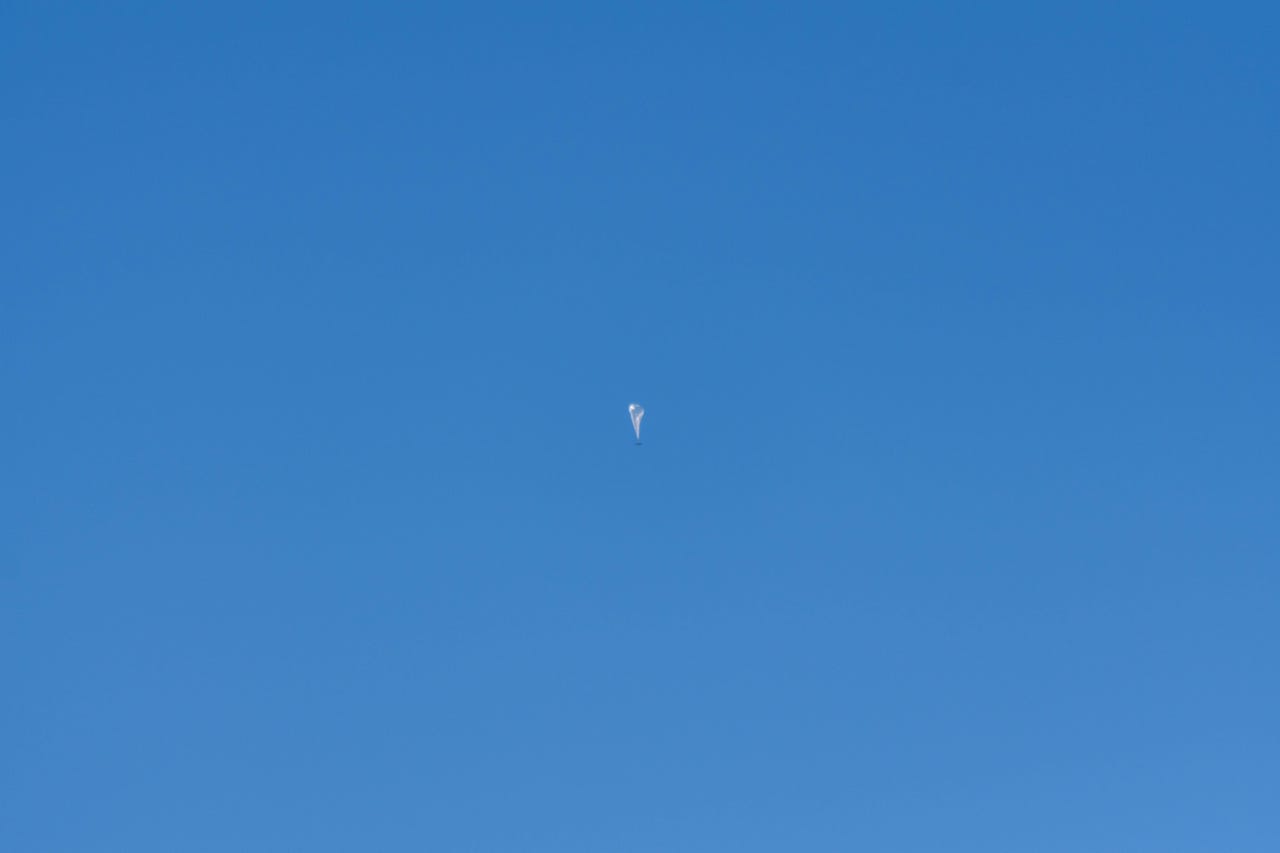Keep watching the skies: Soon it will be where the internet comes from

The X-Files had it right: we need to keep looking up. After all, you never know what you might see. Take the other Sunday morning, when Mary and I were heading off on the next leg of a roadtrip back to the Bay Area after attending a conference in Utah.
We were grabbing a coffee in Winnemucca, slap bang in the middle of the Nevada desert, when she pointed out a bright dot on the horizon. Something silver was catching the morning sun, something that clearly wasn't an aircraft. My camera was in the back of the car, and I took it out to get a closer look through a long lens. What was lifting off from Winnemucca's small airport was a high altitude balloon, very much like those used to monitor the weather.

Our first sighting of a Project Loon balloon over Winnemucca, Nevada, shortly after launch.
We drove a little further, and pulled off the highway, right under the climbing balloon.
Underneath a Project Loon balloon, as it climbs into the Nevada sky.
However, it clearly wasn't carrying a set of weather sensors. Instead of a small cluster of instruments, below the balloon was a large flat surface, and what appeared to be a long antenna. We'd seen pictures of this before: what we were seeing was one of Google's Project Loon balloons being launched on a test flight.
Google's X - previously Google X - research lab been using Winnemucca's airport for Project Loon for a year or so. It's a good place for the company to try out its high-altitude internet delivery service: the airfield is close to a major highway, and well away from large cities and busy airspace. A balloon launched from Winnemucca can quickly climb to 60,000 ft, and then drift across relatively un-populated lands on predictable westerly and southerly winds.
Designed to deliver internet service to wide areas without installing significant infrastructure, Project Loon involves launching transmitters under high-altitude balloons, using the different directions of winds at different altitudes to orbit the balloon over a large area of land. What we saw looking at the balloon was the equipment Google uses to handle both the balloon controls and its data services. That large flat surface we could see was the transmitter's solar panel, and the antenna was likely to be the LTE transmitter that Google has licensed for its tests.
As the balloon rose into the sky we drove to the outskirts of the town to watch its ascent from a better angle. From below the balloon, you could see its solar panels, and we watched it until it was hard to focus on the payload with a 300mm lens.
It's apparently a good time of the year to see Project Loon balloons. Looking at Flightradar24, they currently appear to be launched almost weekly (do a search for HBAL to see if one's currently in the air). Most seem to drift east down the Humboldt River valley towards Salt Lake City and the high desert plains between the Wasatch mountains and the Rockies, at a steady 30mph.
A Project Loon balloon drifts across the American West. They're easy to track using apps like Flightradar 24.
Winnemucca isn't the only test site for Project Loon. Using Flightradar 24 I've found the balloons over the Amazon, orbiting over the Caribbean, and drifting up and down the Peruvian coast.
Getting the internet to the unwired world is an interesting problem, and Project Loon is only one route to delivering high-bandwidth connectivity. Facebook is also experimenting with airborne internet, using its solar-powered Aquila drones. Designed to loiter at high altitude for weeks at a time, Aquila is an intriguing alternative to Google's simpler balloons. With drones like Facebook's, it'll be easier to target specific locales with bandwidth as and when needed -- but it will be more expensive to build and operate a fleet of drones than a fleet of balloons. Meanwhile Microsoft Reasearch is using white spaces technology to take advantage of local mesh networks with low coat radios.
A cluster of Project Loon balloons over the Caribbean.
As the Project Loon balloon rose into the clear desert sky and drifted off into the east, it left us thinking about the way in which bandwidth, like civilization, clings to the coastlines. If we're to give everyone on the planet the same access to information and services, no matter where they are, then we're going to need more experiments like Microsoft's, Google's, and Facebook's.
Delivering internet from the air is a fascinating idea, but it's only a start.